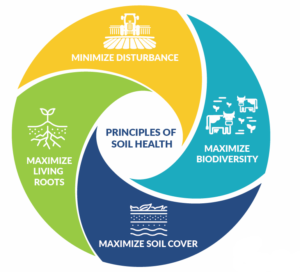Soil health testing is the preferred testing package for government agencies such as United States Department of Agriculture (USDA) and the Natural Resources Conservation Service (NRCS). These tests provide a wholistic view of the quality of a given soil. A healthy soil benefits more than the plants growing in it. As outlined by the USDA, soil provides the following functions:
- “Regulating water – Soil helps control where rain, snowmelt, and irrigation water goes. Water flows over the land or into and through the soil.
- Sustaining plant and animal life – The diversity and productivity of living things depends on soil.
- Filtering and buffering potential pollutants – The minerals and microbes in soil are responsible for filtering, buffering, degrading, immobilizing, and detoxifying organic and inorganic materials, including industrial and municipal by-products and atmospheric deposits.
- Cycling nutrients – Carbon, nitrogen, phosphorus, and many other nutrients are stored, transformed, and cycled in the soil.
- Providing physical stability and support – Soil structure provides a medium for plant roots. Soils also provide support for human structures and protection for archeological treasures.”
https://www.nrcs.usda.gov/wps/portal/nrcs/detailfull/national/soils/health/?cid=stelprdb1048783
Proper management techniques such as crop rotations, cover crops, reduced and no-till operations promote healthy soils that will continue to provide these functions for years to come.
Soil health testing incorporates this multi-faceted approach to managing soils by analyzing the following biological, chemical, and physical factors:
Biological:
- Autoclaved citrate extractable (ACE) Protein
- Nitrogen is a main component in amino acids, the building blocks of proteins. Adequate nitrogen (protein) is essential for all organisms that grow in soil for protein synthesis. ACE Protein quantifies the level of bioavailable nitrogen in a soil.
- Soil Respiration
- Soil microbes drive many of the nutrient cycles in soil. A healthy soil relies on healthy microbial populations
- 28-day Mineralized Nitrogen
- Mineralization (sometimes known as ammonification) is the process by which organic matter in the soil is broken down by biological processes to form inorganic, plant available nitrogen forms.
Chemical:

USDA-NRCS Graphic
- Active Carbon (POX C)
- Carbon is the backbone of all living things. While plants use CO2 as their carbon source, any non-photosynthesizing organism relies on other available carbon forms. The greater the pool of carbon in a soil, the greater the amount of available carbon for soil dwelling organisms.
- Organic Carbon and Nitrogen
- The total amount of organic matter in the soil in both available and unavailable forms. The greater the concentration of organic carbon and nitrogen, the greater potential for microbial activity to create bioavailable nitrogen and carbon.
Physical:
- Aggregate Stability
- The ability to form aggregates prevents soil from becoming massive in structure. Massive structured soils lead to flooding and infertility as water and nutrients are unable to penetrate the soil surface.
- Soil Texture
- The texture of a soil affects the water and nutrient holding capacity of that soil.
- Water Holding Capacity
- A healthy soil will retain some water for plant use without flooding or becoming saturated.
| Analysis | Cost |
| Active Carbon (POX C) | $24 |
| Aggregate Stability | $36 |
| ACE Protein | $36 |
| Soil Respiration | $30 |
| Soil Organic Carbon and Nitrogen | $27 |
| 28-day Mineralized Nitrogen | $36 |
| Soil Health Basic Package (Active Carbon, Aggregate Stability, ACE Protein, Soil Respiration, and Soil Organic Carbon and Nitrogen) | $145 |
| Soil Health Standard Package (includes Soil Health Basic Package, test 1*, CEC, texture, water holding capacity) | $221 |
*Analysis included in a soil test 1 package can be found on this page of our website: http://soiltestlab.com/forms-downloads/analysis-request-forms/
